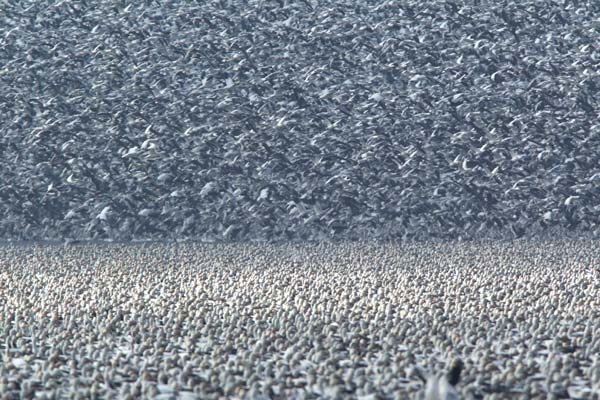
By Dan Zarlenga, Missouri Department of Conservation
Photo Caption: Hundreds of thousands of snow geese can descend in winter wetlands like snow itself. Photo courtesy of the Missouri Department of Conservation
Sometimes it rains cats and dogs. Sometimes, it snows geese.
As one might guess, the snow goose gets its name from its brilliant white plumage. The tips of its wings are black, and the snow goose features a chunky, pink bill with markings that look like the bird carelessly smeared black lipstick on itself while trying to fly. In a somewhat better flair for fashion, snow geese feature legs and feet that closely match the color of their bills. There is also a blue morph of the species which is less common—these variants are mostly grayish brown, with a white head and neck, and white on the underside of their wings.
Snow geese have something else in common with snow—we see them in winter. Their populations peak in Missouri during December. These migratory birds spend the colder months in latitudes as far south as the Show-Me-State. We might think winter months around here are chilly, but this area must seem downright warm compared to the snow goose’s northern nesting grounds—the arctic tundra regions of extreme northern Canada, Alaska, and Greenland. They spend May through August there mating, nesting, and rearing young.
And like snowflakes, snow geese can come down from the winter sky by the hundreds of thousands. These geese hang out in extremely large numbers among marshes, rivers, lakes, and crop fields. Together, their individual calls combine into a high-pitched roar that can be almost deafening when they take off and land en masse. Birdwatchers thrill at the spectacle and waterfowl hunters welcome the arrival of snow geese as popular wintertime quarry.
Snow geese even act a bit like snow shovelers as they dig up roots of marsh plants to eat. Thanks to human farming, snow geese have expanded their diet in the last hundred years to a feast on leftover grain and other agricultural waste in crop fields, in addition to fields of rice, wheat, corn, and other grains.
When snow gets too deep however, it can become a hazard; and it’s the same with snow geese. The availability of new food sources in recent years has caused their populations to boom. It’s estimated there are more than 5 million breeding snow geese, and the population is growing by over five percent each year. The overwhelming numbers of snow geese are becoming increasingly destructive to the delicate tundra ecosystems. The birds now overgraze their arctic nesting range and as a result, large areas of the tundra are becoming degraded. This makes it difficult for other species that depend on the unique environment to survive.
To address the problem, Federal and state wildlife management agencies have liberalized snow geese hunting regulations in hopes that an increased harvest can help restore balance to the tundra.
So, while raining cats and dogs may be just a saying, hundreds of thousands of these white waterfowl descending from a winter’s sky proves that it truly does snow geese.
For more information, visit www.mdc.mo.gov


